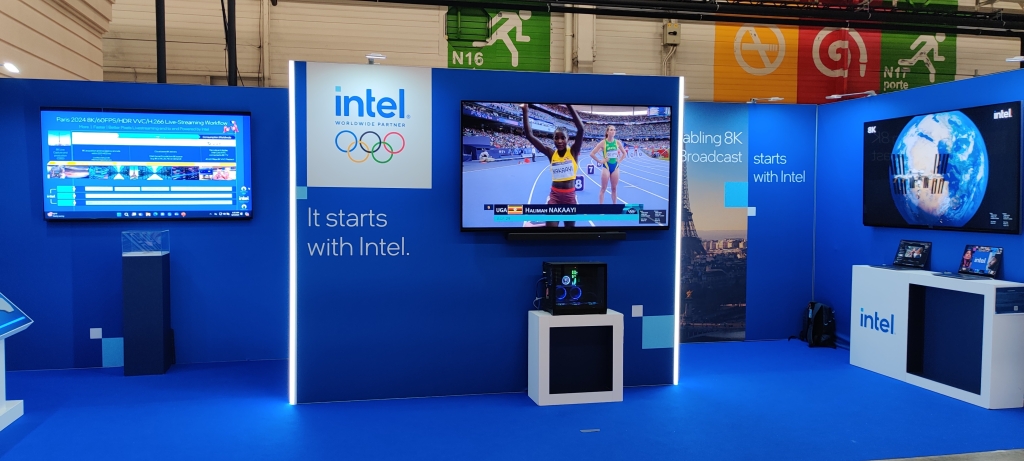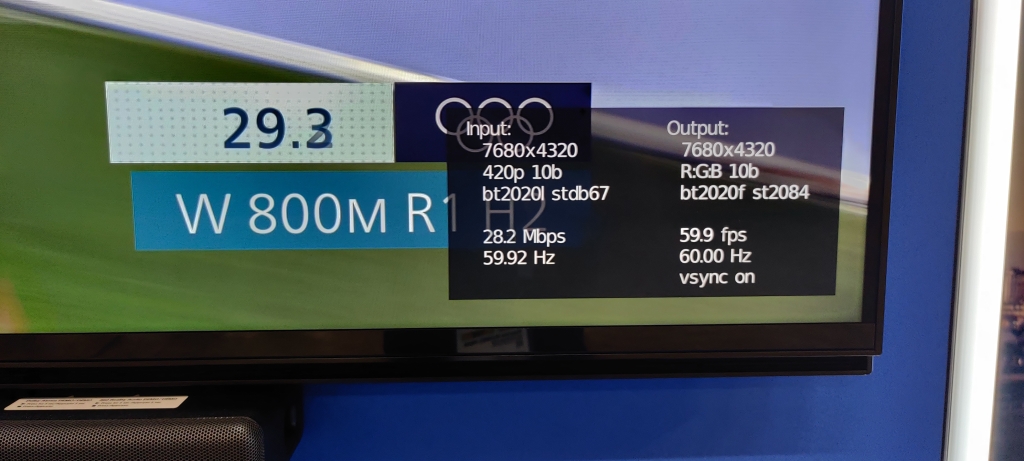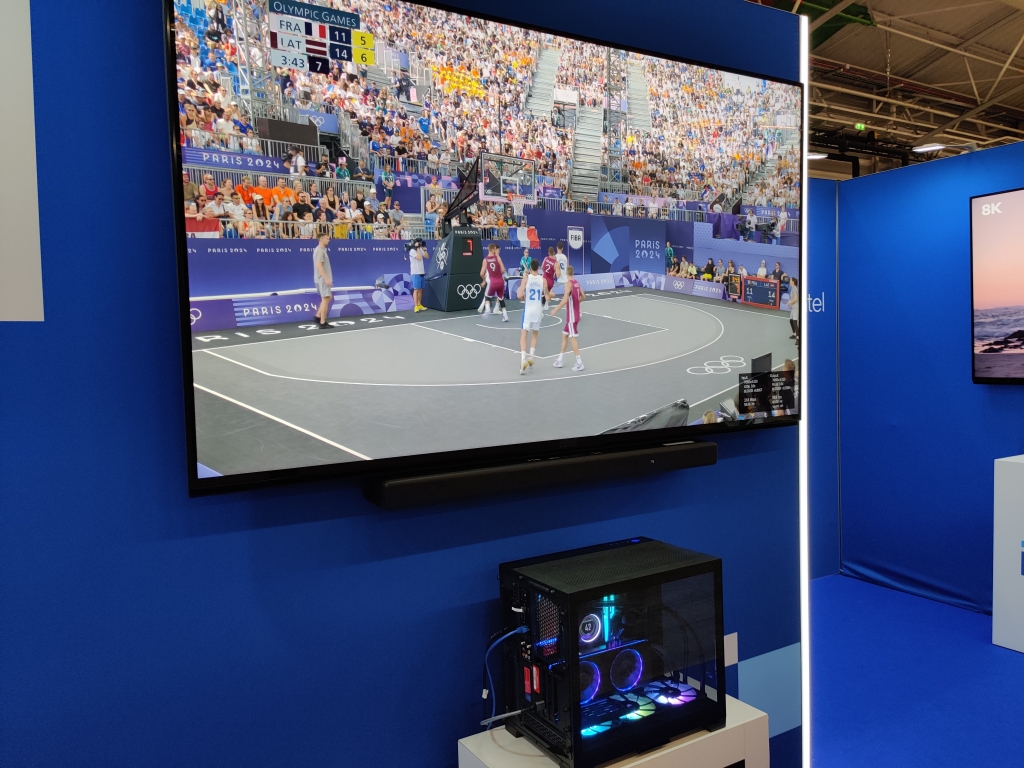NEWS
EVENTS / August 15, 2024
8K live streaming presented by Intel at Paris Olympics
Intel, a long-standing Olympics partner, presented a live stream of Olympic competitions in 8K from July 26th to August 11th. These were delivered to selected media rights holders around the world.
The demonstration of 8K live streaming in Paris has been probably the largest deployment of 8K and VVC until now and puts 8K live streaming one step closer to end consumers.
The Intel official press release can be found here: “At Olympic Games Paris 2024, Intel AI Platforms Showcase World’s First 8K OTT Broadcast”.
The main technical specifications and achievements are summarized below and explained in more detail in this article:
- Olympics sports in 8K video at 60 fps with 10-bit HDR
- Live encoding using a software VVC/H.266 encoder
- Delivery over the Internet via open cloud to several locations worldwide
- Decoding and playback using a VVC software media player
- Additional 8K contribution feed using HEVC 4:2:2 at 300 Mbit/s
- Next-generation immersive audio using MPEG-H
The Olympics in 8K: looking better than ever
The first thing we noticed was the impressive quality of the 8K production. It is remarkable how 8K technology and content production have improved in the last few years: cameras, lenses, live mixing, color processing and HDR all have significantly advanced to offer a richer visual experience exploiting the potential of the 8K format.

The content was captured, processed, encoded, delivered and displayed in 8K resolution (7680×4320 pixels) at 60 frames-per-second (to be exact at 59.94 fps) with 10-bit HDR. For sports content, 8K at 60 fps makes a real difference, in fact, one could say it is the minimum for a good overall quality, and even higher frame rates appear to be the logical next step for fast moving sports.

The 8K content originated mainly from two venues in Paris: La Concorde with the new urban sports: Basketball 3×3, Breaking, and Skateboard; and Stade the France for traditional Athletics competitions. The live production was carried out by the Japanese broadcaster Nippon Hōsō Kyōkai (NHK), and the Chinese broadcaster China Media Group (CMG), both working in collaboration with the Olympics Broadcasting Services (OBS).
8K live encoding: making 8K a viable reality
Intel showed a live encoder running on-premises at its own booth at the International Broadcast Center (IBC) located at the Exhibition Center of Le Bourget, ten kilometers north of Paris.
The uncompressed 8K signal arrived from OBS via SDI over fiber optic in an uncompressed format at 48 Gbps. Advanced video compression is crucial to reduce this data rate to a level that allows wide and cost effective distribution. For the Paris Olympics 2024, Intel was using the latest video coding standard VVC (also known as H.266) that allows the reduction of the bitrate compared to previous codecs (including HEVC) at the same perceptual quality.
The slides below, presented by Intel at the IBC booth, show a high-level view of the live streaming workflow, highlighting the 8K encoder, cloud streaming, and 8k media players at the viewing locations.


The 8K video was encoded using a CPU-based software encoder (Spin Digital’s Spin Enc Live) which was optimized for the latest 5th Gen Intel Xeon processors (also known as Emerald Rapids). A server with two Xeon Platinum 9592+ processors (with 2×64 cores) was showcased for 8K 60 fps 10-bit live encoding.
The encoder uses advanced content-aware and perceptually-optimized encoding algorithms to compress the 8K live feed in real-time, with low-latency, broadcast-grade quality, and low bitrate. The bitrate was adapted dynamically depending on the content complexity, with an average of 30 Mbps and a maximum of 60 Mbps.
As a reference it is worth mentioning that in the last Olympic Games in Tokyo in 2021, Intel also presented a demonstration of 8K live streaming. Using a software HEVC encoder (also Spin Enc Live) the delivery bitrate was 50 to 80 Mbit/s. For more technical details on the 8K live streaming at the Tokyo Olympics, see this article: “Intel demoed 8K HDR streaming from the Tokyo Olympics”
The remarkable bitrate reduction from Tokyo to Paris is the result of three main advances:
- New video codec: from HEVC to VVC, a new generation of video codec allows the reduction of the bitrate at the same perceptual quality. For 8K live encoding applications, a reduction of 25% has been reported.
- Improved coding algorithms: new techniques to reduce the bitrate at the same quality, including, a.o. perceptually-optimized encoding and content-aware encoding.
- Optimization for new CPU platforms. The encoder has been optimized for the latest Intel Xeon 5th Gen (Emerald Rapids) which provides more cores (up to 128 cores in a dual socket configuration) and higher performance per core compared to the previous generations. In Tokyo, 8K HEVC live encoding was performed with Intel Xeon 3rd Gen, Cooper Lake processors.
A paper from the IBC 2023 Conference provides more technical details about the compression efficiency of the VVC encoder for 8K live applications: “A Real-Time 8K-60-fps-HDR VVC/H.266 Software Encoder For Next-Generation Live Applications”.

Delivery over the open internet: 8K for all
The 8K compressed stream was delivered over the public Internet to multiple locations across the world using cloud-based streaming and content delivery networks (CDNs). There were viewing locations in Paris and other cities around the world including Seattle, Hillsboro, Santa Clara, and Los Angeles (Hollywood) in the USA; Berlin in Germany; London in the UK; Mumbai in India; Penang in Malaysia; and Sao Paulo and Rio de Janeiro in Brazil. See the figure below for a map of the different locations.

Intel stressed the point that commercial cloud and CDN services were used without special optimizations for 8K. The bitrate was low enough to use existing cloud delivery infrastructure without changes.
In Brazil, Globo, the Brazilian private broadcaster, presented the 8K Olympics content in connection with the TV 3.0 project that aims to create a next-generation broadcasting platform combining the best of traditional television with the capabilities of the Internet. It includes significantly enhanced visual and audio experiences, with up to 8K resolution using the VVC video and MPEG-H audio codecs.
More details, in Portuguese, are provided by Globo in its official announcement: “In partnership with Intel, Globo will demonstrate the Paris 2024 Olympic Games in 8K in Brazil”.
Decoding and Playback: making 8K easier
At the receiver side, a software Media Player (Spin Digital’s Spin Player), was used to playback the 8K VVC internet stream. The decoding PC is a desktop class PC based on an Intel Core i9-14900K processor for video decoding and an Intel ARC A770 GPU for video rendering and displaying. The media players were connected to 8K TVs using the HDMI 2.1 interface.
In addition to the desktop PC, Intel presented an “8K laptop”. Based on the Core Ultra 9 processor (also known as Meteor Lake), the laptop was used for 8K HEVC playback. In this case the 8K files were encoded with HEVC/H.265 codec and the same media player was used for playback. By comparison, for the Tokyo Olympics a Workstation PC (based on an Intel Xeon W-2295 processor) was used for the same task.
Looking ahead, in the near future VVC hardware accelerated decoders will become available, enabling 4K and 8K playback of the latest video standard for small form factor PCs and laptops.

The 8K live stream was produced using HDR with HLG format and was converted in real-time by the media player to HDR10 (PQ) format before display. HLG is the preferred format for broadcasters for live sports, and PQ is the preferred format for HDR in desktop PCs. Format adaptation remains an important feature for 8K media players.
8K video and immersive 3D audio
The 8K video was complemented by immersive 3D audio. The content was produced in 3D multi-channel audio format with the primary goal of creating a more immersive sound experience. Some of the content was produced using the 22.2 channel format used in Japan by NHK, some in 5.1.4 channel audio format.
The audio was encoded using MPEG-H audio codec which offered high quality, immersive 3D and device adaptation. With MPEG-H, all locations received the same audio stream and converted it, using the integrated audio renderer, to their own target speaker layout; for example 22.2, 5.1.4, 5.1, or stereo.
This was another advancement compared to the Tokyo Olympics, where immersive audio and device adaptation was performed by delivering three audio tracks in 22.2, 5.1, and 2.0 channels encoded in AAC. MPEG-H, in comparison, provides more flexibility, higher quality and less overall bitrate.
HEVC for 8K contribution
In addition to the VVC/H.266 streaming for final distribution, Intel simultaneously produced a “contribution 8K stream”. This is a high bitrate and high quality format that can be used for later processing including transcoding for different resolutions and codecs.
The contribution stream was encoded in HEVC with a 4:2:2 chroma format at 300 Mbit/s (also using Spin Enc Live), in this case running on a server equipped with two Xeon Platinum 8480+ processors (with 2×56 cores).
Using HEVC with a software encoder for contribution has significant benefits:
- High compression: instead of recording at the uncompressed rate of 48 Gbps, HEVC can offer a mezzanine file quality at 300 Mbit/s, which is 160 times less data.
- Cost-effective and scalable: By using a CPU-based encoder with server-level storage it is possible to create a cost-effective solution that can scale for large capacity and allows recording in contribution format for hundreds of hours.
Beyond the Olympics. 8K distribution is ready
All in all, the problem of delivering 8K live content can be considered “solved”. The quality, bitrate, encoding features, performance and cost have all achieved the level required for deployment.
By using VVC combined with advanced perceptual encoding and content-aware encoding, it is possible now to deliver 8K live streaming for sports (8K at 60 fps with HDR) over the open internet using current content delivery networks.
In this regard, what Intel presented in Paris, and with its partners across the world, is more than a technical demonstration. Based on commercially available hardware platforms (e.g. Intel Xeon 5th Gen processors) and software applications (e.g. optimized live encoders), this is a significant milestone in the development of 8K live media and entertainment.
Content owners and producers can now take advantage of these technologies and offer prime 8K live content at scale over the Internet to viewers around the world.

More information and references
- Intel official PR: At Olympic Games Paris 2024, Intel AI Platforms Showcase World’s First 8K OTT Broadcast.
- 8K Association article: Intel’s 8K Live Olympic Masterclass Highlights the Immersion of 8K Sports
- NAB Amplify article: What the 8K OTT Tests at the Olympics Signal to Broadcasters.
- Globo PR (in Portuguese): Em parceria com Intel, Globo fará demonstrações dos Jogos Olímpicos de Paris 2024 em 8K no Brasil.
- 8K live streaming in India: 8K live-streaming comes to India at Whistling Woods International, powered by Intel in association with OBS..
- IBC 2023 technical paper: A Real-Time 8k-60-Fps-Hdr VVC/H.266 Software Encoder For Next-Generation Live Applications.
Trademarks
Intel, the Intel logo, and other Intel marks are trademarks of Intel Corporation or its subsidiaries. For more information visit: https://www.intel.com